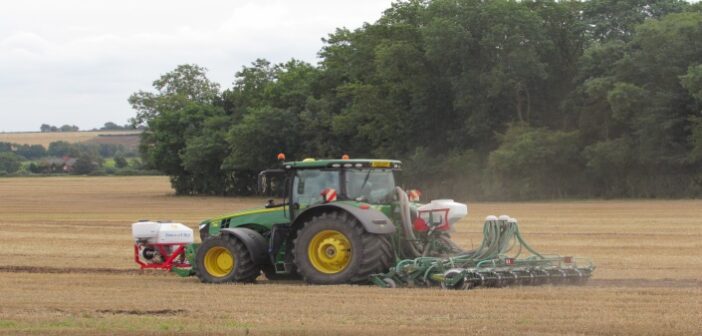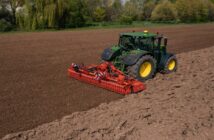Simultaneously applying both a companion crop and slug pellets with direct drilled rapeseed into stubble has allowed David Roberts, of D S Roberts and Son to drive OSR performance.
Mr Roberts runs the 400ha arable farm in partnership with his father Denis nr Tamworth, Staffs, and previous performance was sometimes handicapped by workloads and the weather. So, they invested in both the Multicast Duo and Multicast 200 applicators to reduce crop passes and help establish the farms’ oilseed rape crop earlier.
David Roberts noted: “We’re a fourth-generation family farm employing two seasonal staff to support me and my father with a key business aim of establishing high-yielding winter crops. Our current rotation is 2 x wheats followed by 1 rape, which although agronomically challenging, is still the most profitable rotation for the business.
“Up until 2021 we still employed a minimum tillage approach to rape establishment using a Simba subsoiler and 2 passes with a Vaderstad Carrier to prepare the soil before drilling. With additional passes for applying slug pellets and then rolling, together with occasional poor weather post-harvest, this often delayed our rape establishment, pushing the rape crop back several weeks and putting us under pressure during an already congested early autumn window.
“With a lengthier rape establishment process, we also historically needed extra labour to complete the task, so when we lost one of our seasonal staff in 2021 the idea of simplifying the whole process from 6 or 7 passes to just 2 passes in order to get the rape away earlier and reduce some of our upfront costs seemed a logical move for the business.
The Multicast Duo is mounted on the front linkage of a John Deere 8370R tractor. It uses 2 separate tanks, metering units and control systems to enable The Roberts’ to apply rapeseed and a cover crop mix of Buck wheat, Berseem clover and Fenugreek that is direct drilled into stubble using a rear-mounted Cousins low-disturbance drill.
Mounted on top of the Cousins machine via a “T” frame we have a Multicast 200 which is used to apply slug pellets in the same pass.
Both applicators use powerful hydraulic fans and Garmin GPS speed controllers to ensure each product is accurately applied via a distribution header. “From an operator perspective, the applicators were quick to set up, easy to calibrate and with in-cab control systems it’s easy to monitor application rates and check when you need to refill the hoppers. As our first tractor lifts a band of soil to establish the rapeseed in, simultaneously applying slug pellets and the companion crop, our second tractor follows behind with a set of rolls to roll the new crop down tight – effectively sealing in any moisture beneath the stubble to create a micro-climate enabling the new oilseed rape seedlings to quickly establish,” notes David Roberts.
Over the last 2 seasons, they used the 2-pass strategy to establish over 130ha of oilseed rape and it has successfully allowed the rape away earlier, helping it to grow away from key pests such as cabbage stem flea beetle (CSFB) and slugs. “With so many of the costs for oilseed rape front loaded, its economically critical to get any rape crop off to the best start possible,” he adds.
“Using the Techneat applicators ensures that we combine 3 separate tasks into a single pass and reduces the overall number of passes. This can often also help take bad weather out of the equation, using a new 2-pass system that can establish 140ha of oilseed rape in 1 week. Although time saving is the key driver for us, it’s hard to ignore the economic benefits of reduced fuel and less labour, as well as the environmental pluses of protecting our soil. In 2021, using the minimum tillage approach of several passes to establish our rape we achieved average rape yields of 3.7t/ha. However, this year using the new 2-pass approach and direct drilling into stubble, we achieved average yields of 4.1t/ha.
“Beyond lengthening some of the pipework when setting up the applicators, no special modifications were required, and Techneat were hands-on in helping us with advice and support on tray testing once we were ready to calibrate. Given our initial success we may extend the use of the applicators to apply starter fertiliser when establishing our winter wheat or possibly on winter beans, should we decide to widen our current rotation to include pulses” he concludes.




